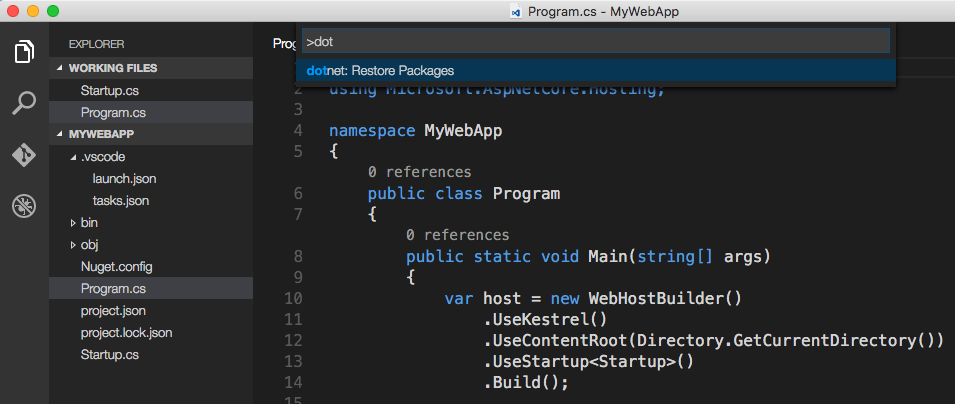Installation
- Download Visual Studio Code for macOS.
- Double-click on the downloaded archive to expand the contents.
- Drag
Visual Studio Code.appto theApplicationsfolder, making it available in theLaunchpad. - Add VS Code to your Dock by right-clicking on the icon to bring up the context menu and choosing Options, Keep in Dock.
Since it was released a little more than a year ago, Visual Studio 2017 for Mac has grown from being an IDE primarily focused on mobile application development using Xamarin to one that includes support for all major.NET cross-platform workloads including Xamarin, Unity, and.NET Core. As in Visual Studio 2015 and 2017 on Windows, Roslyn powers the code editor in Visual Studio for Mac, providing an enhanced coding experience with syntax colorization, IntelliSense, live code issue detection, fixes and refactorings. Persistent performance and reliability issues in the Visual Studio for Mac IDE will be addressed by replacing most of the editor internals with code from the Visual Studio Code editor. That news comes in a blog post today (Oct. 16) announcing Visual Studio for Mac 2019 and a new roadmap.
Launching from the command line
I'm down here at the BUILD Conference in San Francisco and Microsoft has just launched Visual Studio Code - a code-optimized editor for Windows, Mac, and Linux and a new member of the Visual Studio Family. While Visual Studio Code is the best IDE for sure but it is really difficult and tiring to try without guide. Here is how to setup Visual Studio Code on Mac for debugging Arduino, WordPress etc common things for the iTerm2 + ZSH + Homebrew Users.
You can also run VS Code from the terminal by typing 'code' after adding it to the path:
- Launch VS Code.
- Open the Command Palette (⇧⌘P (Windows, Linux Ctrl+Shift+P)) and type 'shell command' to find the Shell Command: Install 'code' command in PATH command.
- Restart the terminal for the new
$PATHvalue to take effect. You'll be able to type 'code .' in any folder to start editing files in that folder.
Note: If you still have the old code alias in your .bash_profile (or equivalent) from an early VS Code version, remove it and replace it by executing the Shell Command: Install 'code' command in PATH command.
To manually add VS Code to your path, you can run the following commands:
Start a new terminal to pick up your .bash_profile changes.
Note: The leading slash is required to prevent $PATH from expanding during the concatenation. Remove the leading slash if you want to run the export command directly in a terminal.
Touch Bar support
Out of the box VS Code adds actions to navigate in editor history as well as the full Debug tool bar to control the debugger on your Touch Bar:
Mojave privacy protections
After upgrading to macOS Mojave version, you may see dialogs saying 'Visual Studio Code would like to access your {calendar/contacts/photos}.' This is due to the new privacy protections in Mojave and is not specific to VS Code. The same dialogs may be displayed when running other applications as well. The dialog is shown once for each type of personal data and it is fine to choose Don't Allow since VS Code does not need access to those folders. You can read a more detailed explanation in this blog post.
Updates
VS Code ships monthly releases and supports auto-update when a new release is available. If you're prompted by VS Code, accept the newest update and it will get installed (you won't need to do anything else to get the latest bits).
Note: You can disable auto-update if you prefer to update VS Code on your own schedule.
Visual Studio Code For Machine Learning
Preferences menu
You can configure VS Code through settings, color themes, and custom keybindings and you will often see mention of the File > Preferences menu group. On a macOS, the Preferences menu group is under Code, not File.
Next steps
Free Visual Studio For Mac

Once you have installed VS Code, these topics will help you learn more about VS Code:

- Additional Components - Learn how to install Git, Node.js, TypeScript, and tools like Yeoman.
- User Interface - A quick orientation around VS Code.
- User/Workspace Settings - Learn how to configure VS Code to your preferences settings.
Common questions
Why do I see 'Visual Studio Code would like access to your calendar.'
If you are running macOS Mojave version, you may see dialogs saying 'Visual Studio Code would like to access your {calendar/contacts/photos}.' This is due to the new privacy protections in Mojave discussed above. It is fine to choose Don't Allow since VS Code does not need access to those folders.